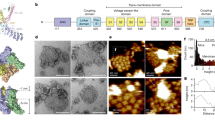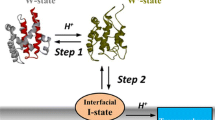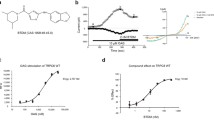Abstract
The translocation domain (T-domain) of diphtheria toxin contains 10 α helices in the aqueous crystal structure. Upon exposure to a planar lipid bilayer under acidic conditions, it inserts to form a channel and transport the attached amino-terminal catalytic domain across the membrane. The TH5, TH8, and TH9 helices form transmembrane segments in the open-channel state, with TH1–TH4 translocated across the membrane. The TH6–TH7 segment also inserts to form a constriction that occupies only a small portion of the total channel length. Here, we have examined the TH5 segment in more detail, using the substituted-cysteine accessibility method. We constructed a series of 23 mutant T-domains with single cysteine residues at positions in and near TH5, monitored their channel formation in planar lipid bilayers, and probed for an effect of thiol-specific reagents added to the solutions on either side of the membrane. For 15 of the mutants, the reagent caused a decrease in single-channel conductance, indicating that the introduced cysteine residue was exposed within the channel lumen. We also found that reaction caused large changes in ionic selectivity for some mutant channels. We determined whether reaction occurred in the open state or in the brief flicker-closed state of the channel. Finally, we compared the reaction rates from either side of the membrane. Our experiments are consistent with the hypotheses that the TH5 helix has a transmembrane orientation and remains helical in the open-channel state; they also indicate that the middle of the helix is aligned with the constriction in the channel.









Similar content being viewed by others
Abbreviations
- C-domain:
-
Catalytic domain of DT
- DT:
-
Diphtheria toxin
- DTT:
-
Dithiothreitol
- His6-tag:
-
Hexahistidine tag
- I–V :
-
Current–voltage
- MTS:
-
Methanethiosulfonate
- MTS-ACE:
-
[2-(Aminocarbonyl)ethyl] MTS
- MTS-ET:
-
[2-(Trimethylammonium)ethyl] MTS bromide
- SCAM:
-
Substituted-cysteine accessibility method
- T-domain:
-
Translocation domain of DT
References
Bennett MJ, Choe S, Eisenberg D (1994) Refined structure of dimeric diphtheria toxin at 2.0 Å resolution. Protein Sci 3:1444–1463
Berman HM, Westbrook J, Feng Z, Gilliland G, Bhat TN, Weissig H, Shindyalov IN, Bourne PE (2000) The Protein Data Bank. Nucl Acids Res 28:235–242
Chenal A, Prongidi-Fix L, Perier A, Aisenbrey C, Vernier G, Lambotte S, Haertlein M, Dauvergne M-T, Fragneto G, Bechinger B, Gillet D, Forge V, Ferrand M (2009) Deciphering membrane insertion of the diphtheria toxin T domain by specular neutron reflectometry and solid-state NMR spectroscopy. J Mol Biol 391:872–883
D’Silva PR, Lala AK (2000) Organization of diphtheria toxin in membranes. A hydrophobic photolabeling study. J Biol Chem 275:11771–11777
Donovan JJ, Simon MI, Draper RK, Montal M (1981) Diphtheria toxin forms transmembrane channels in planar lipid bilayers. P Natl Acad Sci USA 78:172–176
Dunnill P (1968) The use of helical net-diagrams to represent protein structures. Biophys J 8:865–875
Gordon M, Finkelstein A (2001) The number of subunits comprising the channel formed by the T domain of diphtheria toxin. J Gen Physiol 118:471–480
Greenfield L, Bjorn MJ, Horn G, Fong D, Buck GA, Collier RJ, Kaplan DA (1983) Nucleotide sequence of the structural gene for diphtheria toxin carried by corynebacteriophage β. P Natl Acad Sci USA 80:6853–6857
Hattori M, Gouaux E (2012) Molecular mechanism of ATP binding and ion channel activation in P2X receptors. Nature 485:207–212
Hille B (2001) Ion channels of excitable membranes. Sinauer Associates Inc, Sunderland, MA, p 451
Hoch DH, Romero-Mira M, Ehrlich BE, Finkelstein A, DasGupta BR, Simpson LL (1985) Channels formed by botulinum, tetanus, and diphtheria toxins in planar lipid bilayers: relevance to translocation of proteins across membranes. P Natl Acad Sci USA 82:1692–1696
Hu VW, Holmes RK (1984) Evidence for direct insertion of fragments A and B of diphtheria toxin into model membranes. J Biol Chem 259:12226–12233
Huynh PD, Cui C, Zhan H, Oh KJ, Collier RJ, Finkelstein A (1997) Probing the structure of the diphtheria toxin channel. Reactivity in planar lipid bilayer membranes of cysteine-substituted mutant channels with methanethiosulfonate derivatives. J Gen Physiol 110:229–242
Kagan BL, Finkelstein A, Colombini M (1981) Diphtheria toxin fragment forms large pores in phospholipid bilayer membranes. P Natl Acad Sci USA 78:4950–4954
Karlin A (2001) SCAM feels the pinch. J Gen Physiol 117:235–237
Karlin A, Akabas MH (1998) Substituted-cysteine accessibility method. Method Enzymol 293:123–145
Kienker PK, Wu Z, Finkelstein A (2015) Mapping the membrane topography of the TH6-TH7 segment of the diphtheria toxin T-domain channel. J Gen Physiol 145:107–125
Krantz BA, Melnyk RA, Zhang S, Juris SJ, Lacy DB, Wu Z, Finkelstein A, Collier RJ (2005) A phenylalanine clamp catalyzes protein translocation through the anthrax toxin pore. Science 309:777–781
Lai B, Zhao G, London E (2008) Behavior of the deeply inserted helices in diphtheria toxin T domain: helices 5, 8, and 9 interact strongly and promote pore formation, while helices 6/7 limit pore formation. Biochemistry 47:4565–4574
Montal M (1974) Formation of bimolecular membranes from lipid monolayers. Method Enzymol 32:545–554
Montecucco C, Schiavo G, Tomasi M (1985) pH-dependence of the phospholipid interaction of diphtheria-toxin fragments. Biochem J 231:123–128
Murphy JR (2011) Mechanism of diphtheria toxin catalytic domain delivery to the eukaryotic cell cytosol and the cellular factors that directly participate in the process. Toxins (Basel) 3:294–308
Oh KJ, Zhan H, Cui C, Hideg K, Collier RJ, Hubbell WL (1996) Organization of diphtheria toxin T domain in bilayers: a site-directed spin labeling study. Science 273:810–812
Oh KJ, Senzel L, Collier RJ, Finkelstein A (1999a) Translocation of the catalytic domain of diphtheria toxin across planar phospholipid bilayers by its own T domain. P Natl Acad Sci USA 96:8467–8470
Oh KJ, Zhan H, Cui C, Altenbach C, Hubbell WL, Collier RJ (1999b) Conformation of the diphtheria toxin T domain in membranes: a site-directed spin-labeling study of the TH8 helix and TL5 loop. Biochemistry 38:10336–10343
Ros U, García-Sáez AJ (2015) More than a pore: the interplay of pore-forming proteins and lipid membranes. J Membr Biol 248:545–561
Rosconi MP, London E (2002) Topography of helices 5-7 in membrane-inserted diphtheria toxin T domain: identification and insertion boundaries of two hydrophobic sequences that do not form a stable transmembrane hairpin. J Biol Chem 277:16517–16527
Rosconi MP, Zhao G, London E (2004) Analyzing topography of membrane-inserted diphtheria toxin T domain using BODIPY-streptavidin: at low pH, helices 8 and 9 form a transmembrane hairpin but helices 5-7 form stable nonclassical inserted segments on the cis side of the bilayer. Biochemistry 43:9127–9139
Senzel L, Huynh PD, Jakes KS, Collier RJ, Finkelstein A (1998) The diphtheria toxin channel-forming T domain translocates its own NH2-terminal region across planar bilayers. J Gen Physiol 112:317–324
Senzel L, Gordon M, Blaustein RO, Oh KJ, Collier RJ, Finkelstein A (2000) Topography of diphtheria toxin’s T domain in the open channel state. J Gen Physiol 115:421–434
Silverman JA, Mindell JA, Zhan H, Finkelstein A, Collier RJ (1994) Structure-function relationships in diphtheria toxin channels: I. Determining a minimal channel-forming domain. J Membr Biol 137:17–28
Tanaka K, Caaveiro JMM, Morante K, González-Mañas JM, Tsumoto K (2015) Structural basis for self-assembly of a cytolytic pore lined by protein and lipid. Nat Commun 6:6337. doi:10.1038/ncomms7337
Wang J, London E (2009) The membrane topography of the diphtheria toxin T domain linked to the A chain reveals a transient transmembrane hairpin and potential translocation mechanisms. Biochemistry 48:10446–10456
Wilson GG, Karlin A (1998) The location of the gate in the acetylcholine receptor channel. Neuron 20:1269–1281
Zalman LS, Wisnieski BJ (1984) Mechanism of insertion of diphtheria toxin: peptide entry and pore size determinations. P Natl Acad Sci USA 81:3341–3345
Zhan H, Oh KJ, Shin Y-K, Hubbell WL, Collier RJ (1995) Interaction of the isolated transmembrane domain of diphtheria toxin with membranes. Biochemistry 34:4856–4863
Zhao G, London E (2005) Behavior of diphtheria toxin T domain containing substitutions that block normal membrane insertion at Pro345 and Leu307: control of deep membrane insertion and coupling between deep insertion of hydrophobic subdomains. Biochemistry 44:4488–4498
Acknowledgments
This work was supported by the National Institutes of Health Grant GM29210.
Author information
Authors and Affiliations
Corresponding author
Ethics declarations
Conflict of interest
The authors declare that they have no conflict of interest.
Research involving human and animal rights
This article does not contain any studies with human participants or animals performed by any of the authors.
Rights and permissions
About this article
Cite this article
Kienker, P.K., Wu, Z. & Finkelstein, A. Topography of the TH5 Segment in the Diphtheria Toxin T-Domain Channel. J Membrane Biol 249, 181–196 (2016). https://doi.org/10.1007/s00232-015-9859-9
Received:
Accepted:
Published:
Issue Date:
DOI: https://doi.org/10.1007/s00232-015-9859-9




